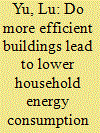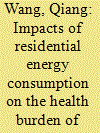|
|
|
Sort Order |
|
|
|
Items / Page
|
|
|
|
|
|
|
| Srl | Item |
| 1 |
ID:
176743


|
|
|
|
|
| Summary/Abstract |
This paper intends to examine the key drivers of household environmental attitudes and energy-saving behavior using both observed and stated attitudinal factors. Beginning with an assessment of energy-saving behaviors Item Response Theory (IRT), we associate hierarchical multivariate regression with an innovative variable selection approach via Elastic Net Selection (ENS). Our empirical study is based on data from the 2012 ENERGIHAB project survey. Empirical evidence in this article contributes with new insights about the main explanatory factors of household energy-saving behavior. The main results further suggest that energy-saving behavior tends to fluctuate throughout time in households. Our findings and approach generate broader methodological insights into energy efficiency analysis through behavioral aspects.
|
|
|
|
|
|
|
|
|
|
|
|
|
|
|
|
| 2 |
ID:
136208


|
|
|
|
|
| Summary/Abstract |
A comprehensive survey of 1450 households in 26 Chinese provinces was undertaken in 2012 to identify the characteristics and potential driving forces of residential energy consumption in China. The survey covers six areas: household characteristics, dwelling characteristics, kitchen and home appliances, space heating and cooling, residential transportation, and electricity billing, metering, and pricing options. The results show that a typical Chinese household in 2012 consumed 1426 kilograms standard coal equivalent, which is approximately 44 percent of the 2009 level in the United States and 38 percent of the 2008 level in the EU-27. District heating, natural gas, and electricity are three major residential energy sources, while space heating, cooking, and water heating are three major end-use activities. Moreover, the results suggest a large urban–rural gap in terms of energy sources and purpose of usage. Commercial energy is used mainly for space heating in urban areas, while biomass dominates mainly for cooking purpose in rural areas. The survey results can help decision makers and scholars identify energy conservation opportunities, and evaluate the effectiveness of energy policies.
|
|
|
|
|
|
|
|
|
|
|
|
|
|
|
|
| 3 |
ID:
094225


|
|
|
|
|
| Publication |
2010.
|
| Summary/Abstract |
Replacing incandescent light bulbs with compact fluorescents (CFLs) has traditionally been seen as a cost effective means of promoting energy conservation. Recently, however, the magnitude of energy savings associated with CFLs has been called into question. Specifically, recent findings suggest an "interactive effect" associated with the replacement of incandescent light bulbs with CFLs in the residential sector. In this scenario, the reduced wattage of CFLs, relative to incandescent bulbs, generates less heat, which in turn, requires additional natural gas usage during the heating season. Engineering studies suggest the magnitude of the effect is significant in energy terms, which implies that the energy savings associated with CFLs may be significantly overstated. In this paper, we use billing analysis to test for the presence of interactive effects. Our analysis is based on a comprehensive dataset that includes monthly household electricity and natural gas usage, the number of CFL bulbs installed, the installation date, and a set of household characteristics. Our results suggest that CFLs do indeed save electricity. However, we do not find any support for the hypothesis that CFLs cause increased usage of natural gas.
|
|
|
|
|
|
|
|
|
|
|
|
|
|
|
|
| 4 |
ID:
186460


|
|
|
|
|
| Summary/Abstract |
Over the last decade, residential energy consumption has become a major contributor to global energy use and carbon emissions, and its contributions, especially in developing regions, are accelerating more rapidly than those of the industrial sector. The energy efficiency of the building stock has shown great potential for reducing household energy consumption through advanced measures on the envelopes of buildings, such as the use of advanced construction materials and improvements in building structures. Thus, policies have been implemented to improve energy efficiency and reduce carbon emissions from buildings. This paper analyses survey data from Guangzhou, a megacity with a subtropical climate in South China, to estimate the effects of energy efficiency on the energy consumption of residential buildings. We apply an econometric approach to examine the effects of energy efficiency, and we employ instrumental variables to address problems of endogeneity. The results show that greener buildings, in terms of advanced building materials and structures oriented towards high energy efficiency, reduce the carbon footprints of households. Additionally, households with low income levels and those with environmentally friendly energy consumption behaviour are likely to benefit from living in energy efficient buildings more than other households. Finally, suggestions on ways to improve energy policy and methods to reduce household energy consumption and carbon (CO2) emissions are presented.
|
|
|
|
|
|
|
|
|
|
|
|
|
|
|
|
| 5 |
ID:
096648


|
|
|
|
|
| Publication |
2010.
|
| Summary/Abstract |
There exist many differences between urban and rural China among which residential CO2 emissions arising from energy consumption is a major one. In this paper, we estimate and compare the energy related CO2 emissions from urban and rural residential energy consumption from 1991 to 2004. The logarithmic mean Divisia index decomposition analysis is then applied to investigate the factors that may affect the changes of the CO2 emissions. It is found that energy intensity and the income effects, respectively, contributed most to the decline and the increase of residential CO2 emissions for both urban and rural China. In urban China, the population effect was found to contribute to the increase of residential CO2 emissions with a rising tendency. However, in rural China, the population effect for residential CO2 emissions kept decreasing since 1998.
|
|
|
|
|
|
|
|
|
|
|
|
|
|
|
|
| 6 |
ID:
097481


|
|
|
|
|
| Publication |
2010.
|
| Summary/Abstract |
There exist many differences between urban and rural China among which residential CO2 emissions arising from energy consumption is a major one. In this paper, we estimate and compare the energy related CO2 emissions from urban and rural residential energy consumption from 1991 to 2004. The logarithmic mean Divisia index decomposition analysis is then applied to investigate the factors that may affect the changes of the CO2 emissions. It is found that energy intensity and the income effects, respectively, contributed most to the decline and the increase of residential CO2 emissions for both urban and rural China. In urban China, the population effect was found to contribute to the increase of residential CO2 emissions with a rising tendency. However, in rural China, the population effect for residential CO2 emissions kept decreasing since 1998.
|
|
|
|
|
|
|
|
|
|
|
|
|
|
|
|
| 7 |
ID:
162950


|
|
|
|
|
| Summary/Abstract |
Recent efforts to reduce residential energy consumption have renewed interest in investigating salient drivers of household energy use. This article contributes to the ongoing literature by developing a model for examining geographic effects on energy use. Using a new, rich, micro-level survey that compiles information about dwelling attributes, occupant characteristics, and behaviors, we suggest a combined bottom-up and top-down statistical approach based on a multilevel regression model (MRM) and an innovative variable selection approach via the Adaptive Elastic Net Regularization technique (AdaEnetR). This approach enables us to extract geographic effects from the total variation in residential energy consumption and simultaneously explain the remaining variation with relevant explanatory variables and their interactions. The current model addresses several interrelated issues posed by the use of econometric methods to examine residential energy demand, including the risk of aggregation/disaggregation bias. Our empirical findings demonstrate the MRM's ability to effectively quantify approximately 0.67% of the geographic effects (aggregate level) and approximately 0.31% of the household and dwelling effects (individual level). Further, the findings show that household attributes are important factors that influence residential energy consumption patterns.
|
|
|
|
|
|
|
|
|
|
|
|
|
|
|
|
| 8 |
ID:
191169


|
|
|
|
|
| Summary/Abstract |
The access that households have to various forms of energy depends on their level of urbanisation, which leads to distinct preferences in the forms of energy they consume. Consequently, different forms of residential energy consumption should have different impacts on energy poverty, when analysed for each degree of urbanisation. Verifying this was the underlying motivation for this study. Thus, it investigates how forms of residential energy consumption (oil, wood/biomass, natural gas, and electricity) impact energy poverty in (a) cities; (b) towns and suburbs; and (c) rural areas. To do so, data from 2005 until 2018 for twelve European countries was analysed using three-panel data sets, one for each urbanisation degree. The results, estimated using Feasible Generalised Least Squares, indicated that, in sparsely populated areas (towns, suburbs, and rural areas), primary energy sources, such as wood/biomass and natural gas alleviate energy poverty. Conversely, in cities, residential electricity consumption has been the key form for decreasing both poverty and energy poverty. The results of this research highlight that energy forms have differing impacts on energy poverty in areas with different levels of urbanisation. Therefore, energy policies should be planned at a disaggregated regional level within countries, and not at a national or European level.
|
|
|
|
|
|
|
|
|
|
|
|
|
|
|
|
| 9 |
ID:
166394


|
|
|
|
|
| Summary/Abstract |
Knowledge about the links between burden from household air pollution (B-HAP) and residential energy consumption (REC) is essential for optimizing residential energy supply mix and improving the quality of indoor air worldwide. However, the literature on this topic from a perspective of energy transition is still lacking. This study investigates the relationship between the variation in the B-HAP and the structural transition of REC using cross-sectional data of 135 countries during 1990–2015. The results indicate that countries with high B-HAP are clustered in Africa and Asia, which are mainly middle- and low-income countries. Meanwhile, with the structural transition of REC, the global B-HAP has exhibited a decreasing trend. Moreover, the findings show that residential electricity use has a greater impact on B-HAP reduction than other household fuels. Although the impacts of liquefied petroleum gas usage changed considerably during the study period, its contribution to reducing the B-HAP remains highly significant, while household natural gas use exhibited a significant and stable effect on B-HAP reduction. In contrast, solid biomass use showed an increasingly adverse impact on the B-HAP, and the impact of coal use on the B-HAP became statistically significant since 2010, with an increasing trend.
|
|
|
|
|
|
|
|
|
|
|
|
|
|
|
|
| 10 |
ID:
191411


|
|
|
|
|
| Summary/Abstract |
Understanding the degree of energy limiting behavior in low-income and vulnerable households is vital to eradicating energy poverty and associated negative health effects. We estimate the outdoor temperatures at which households turn on and off their electricity-based cooling and heating units under a cold climate in northern Illinois, USA (N = 418,255 for cooling; N = 22,628 for electric heating). We find that the cooling energy equity gap between low and high income groups is 3 °F (1.7 °C), while the electric-based heating energy equity gap is 6 °F (3.3 °C). The pattern of energy limiting behavior is found to be different between the cooling season and the heating season. Our metrics contribute to the policy design of home energy bill and weatherization assistance programs to identify vulnerable households in a cold climate: Among low-to-middle-income households, our metric identifies 19,001 households (20%) in the cooling sector and 1,290 households (24%) in the heating sector who may be neglected by the traditional income-based energy poverty measure. We also find that households living in black-majority census block groups have a cooling gap that is 17% wider than households living in white-majority census block groups. Policy design should focus on addressing the income inequality and other systematic inequalities that have impacted Black American households.
|
|
|
|
|
|
|
|
|
|
|
|
|
|
|
|
| 11 |
ID:
183575


|
|
|
|
|
| Summary/Abstract |
This study develops an empirical model to investigate the extent of fuel poverty in two emerging economies, Egypt and Jordan. We also identify explanatory factors for fuel poverty. We use an innovative empirical framework based on a multivariate statistical approach with logistic regression and classification and regression tree models. Using this framework, we evaluate the rates of fuel poverty, the factors contributing to fuel poverty and salient fuel poverty profiles. This analysis is helpful in identifying and targeting the families that most need energy and financial assistance. The results show that the proportion of fuel-poor households is greater in Jordan (15.8%) than in Egypt (8.4%). They also highlight four different energy poverty profiles for each country. The findings show that good economic conditions, reduced inequality and access to education are critical for attenuating fuel poverty in Egypt and Jordan. The analytical framework innovatively captures fuel poverty as a new dimension in the vector of inequality trends in the Middle East and North Africa. The findings offer insights into fuel poverty in developing countries and have important policy implications. Specifically, they provide strategic information for implementing energy policies and programs to reduce inequality in the future.
|
|
|
|
|
|
|
|
|
|
|
|
|
|
|
|
| 12 |
ID:
111369


|
|
|
|
|
| Publication |
2012.
|
| Summary/Abstract |
Residential energy consumption (REC) is the second largest energy use category (10%) in China and urban residents account for 63% of the REC. Understanding the underlying drivers of variations of urban REC thus helps to identify challenges and opportunities and provide advices for future policy measures. This paper applies the LMDI method to a decomposition of China's urban REC during the period of 1998-2007 at disaggregated product/activity level using data collected from a wide range of sources. Our results have shown an extensive structure change towards a more energy-intensive household consumption structure as well as an intensive structure change towards high-quality and cleaner energy such as electricity, oil, and natural gas, which reflects a changing lifestyle and consumption mode in pursuit of a higher level of comfort, convenience and environmental protection. We have also found that China's price reforms in the energy sector have contributed to a reduction of REC while scale factors including increased urban population and income levels have played a key role in the rapid growth of REC. We suggest that further deregulation in energy prices and regulatory as well as voluntary energy efficiency and conservation policies in the residential sector should be promoted.
|
|
|
|
|
|
|
|
|
|
|
|
|
|
|
|
|
|
|
|
|